Ancestral death masks led to the development of various practices in art, culture, and science. They shaped how societies commemorate their deceased, influenced sculptural techniques, and contributed to forensic identification methods. These masks preserved memories and identities, connecting generations through shared legacies. They’ve also inspired modern artists who reinterpret mortality and memory in their work. As you explore further, you’ll uncover even more fascinating aspects of death masks and their lasting impact.
Key Takeaways
- Ancestral death masks influenced the creation of lifelike sculptural busts, emphasizing anatomical accuracy in art.
- They were integral to the preservation of political legacies and family histories in ancient Rome.
- Death masks contributed to forensic identification techniques, aiding in resolving cold cases through detailed representations.
- They inspired modern artists to explore themes of mortality and identity through reinterpretation of the masks.
- Cultural practices surrounding death masks fostered shared memory and continuity across generations, enhancing familial connections.
Historical Significance of Death Masks
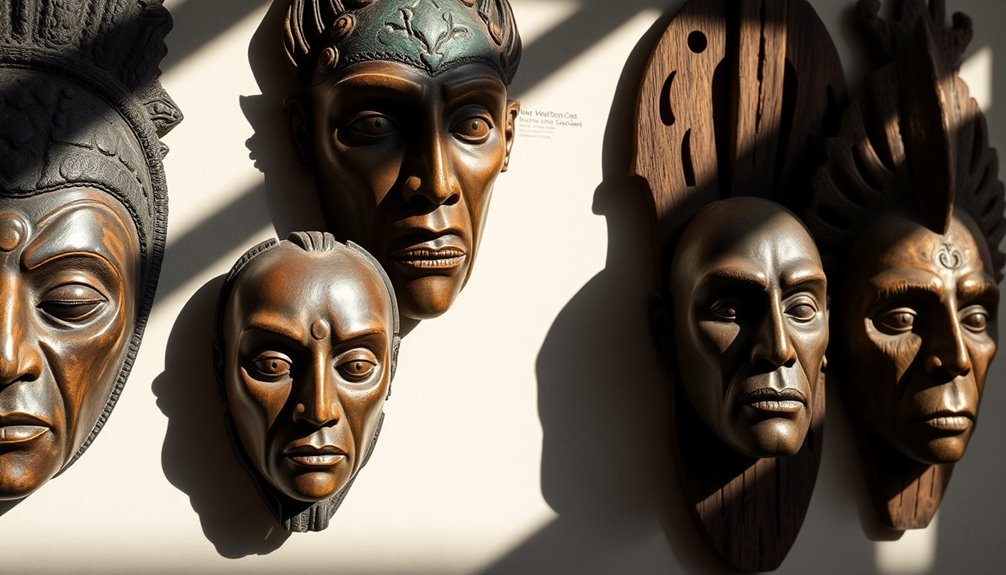
When you think about ancestral death masks, it’s clear they held significant meaning in ancient Roman culture. Known as imagines, these death masks were crafted by elite Romans to honor deceased family members and highlight their political prominence.
Made during the individual’s lifetime, they reflected societal status and were prominently displayed during funerals, inspiring attendees with a sense of patriotic virtue. This practice allowed families to preserve their legacy, as death masks were kept in household shrines alongside other ancestral masks, forging a deep connection to heritage.
The historical significance of these death masks extended beyond Rome, influencing later cultures in their memorialization practices and cementing their role in the evolution of remembrance rituals throughout history.
Artistic Influence and Sculpture
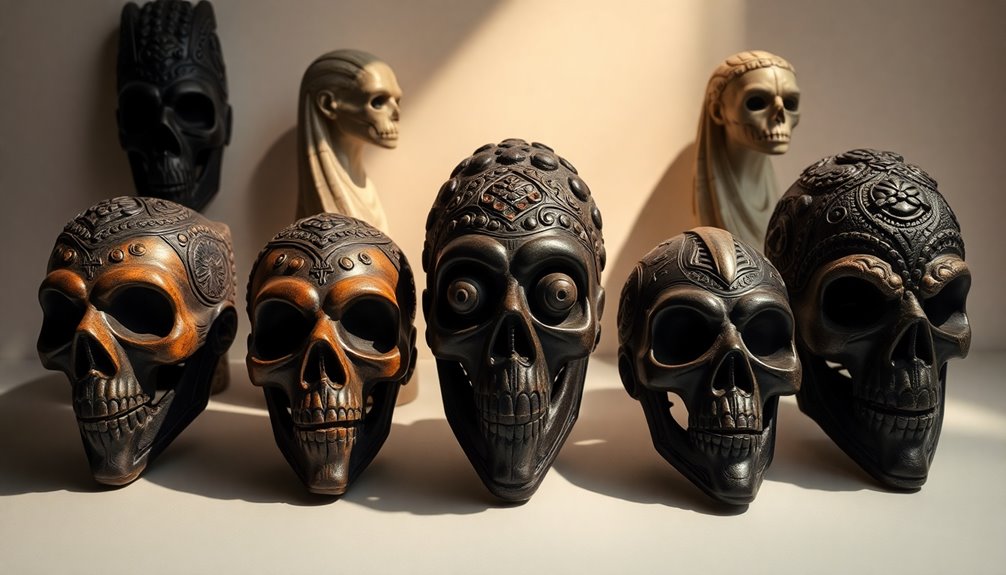
Ancestral death masks considerably influenced the evolution of sculpture and artistic representation. These masks served as direct references, enabling sculptors to create lifelike busts of individuals, especially among royalty and nobility.
Here are four key impacts:
- Realism: Sculptors developed techniques that emphasized anatomical accuracy, moving away from idealized forms.
- Historical Records: Masks of notable figures like Isaac Newton and Napoleon became essential for preserving legacies.
- Emotional Depth: Artists draw from the masks’ aesthetic qualities, capturing the essence of mortality.
- Modern Interpretations: Contemporary artists, such as Tracey Emin, blend historical techniques with personal narratives, exploring themes of memory.
Through these influences, masks have shaped artistic practices, leaving a lasting legacy in sculpture. Additionally, the use of realistic representations in sculpture has parallels to the detailed designs found in air purifiers, which aim to optimize indoor air quality through effective filtration.
Scientific Applications of Death Masks
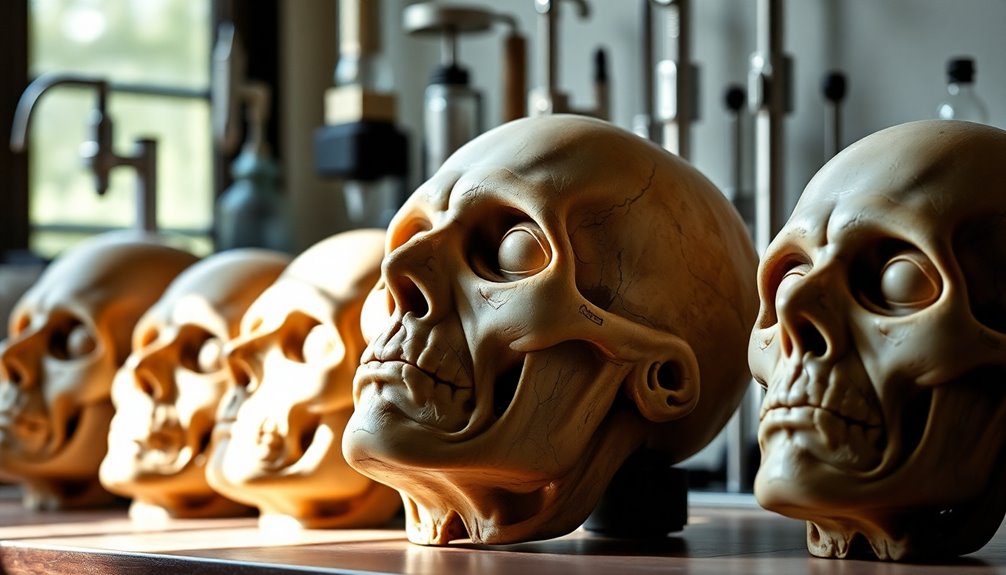
As you explore the scientific applications of death masks, you’ll see their vital role in forensic identification techniques and the study of human physiognomy.
These masks served as essential tools for documenting features of unidentified bodies long before photography was available.
Forensic Identification Techniques
While death masks may seem like relics of the past, their role in forensic science remains significant.
These masks preserve the features of unidentified bodies, providing essential visual records. Here are four ways death masks enhance forensic identification:
- Preservation: They capture intricate details of the deceased’s face before photography was common.
- Reconstruction: Forensic artists replicate masks to aid in reconstructive efforts.
- Cultural Significance: Masks like L’Inconnue de la Seine highlight the blend of art and identification.
- Cold Case Resolution: Their accuracy improves the ability to identify remains and solve long-standing cases.
Physiognomy and Human Study
Though often viewed through the lens of art and history, death masks have played a crucial role in the scientific exploration of physiognomy, the study of how facial features relate to personality and behavior.
Since the late 18th century, scientists have used death masks to document human physiognomy, providing a tangible reference for understanding anatomy and facial structure. Notable examples, like L’Inconnue de la Seine, served as cultural and scientific artifacts, inspiring research on aesthetics and the psychology of beauty.
By creating life masks alongside death masks, researchers established a comparative framework for physical characteristics across populations.
Additionally, death masks proved essential in forensic science, aiding in the identification of unidentified bodies before photography became widespread, showcasing their practical applications in human studies. Furthermore, the study of physiognomy has been linked to understanding mental health disorders, revealing how physical traits can sometimes reflect underlying psychological conditions.
Forensic Science and Identification

Forensic science and identification have evolved markedly since the days of ancestral death masks, which served as essential tools for commemorating the deceased.
These masks laid the groundwork for modern techniques in forensic science, aiding in the identification of individuals. Here are some key contributions:
- Preservation of likeness: Death masks captured facial features, allowing for accurate representations.
- Documentation: They provided a means to document unidentified bodies, essential for law enforcement.
- Scientific study: The late 18th century saw death masks used to study human physiognomy.
- Modern techniques: Innovations like 3D scanning trace their origins back to these early practices.
Today, the legacy of death masks continues to influence forensic identification, bridging art and science in profound ways.
Cultural Practices and Rituals
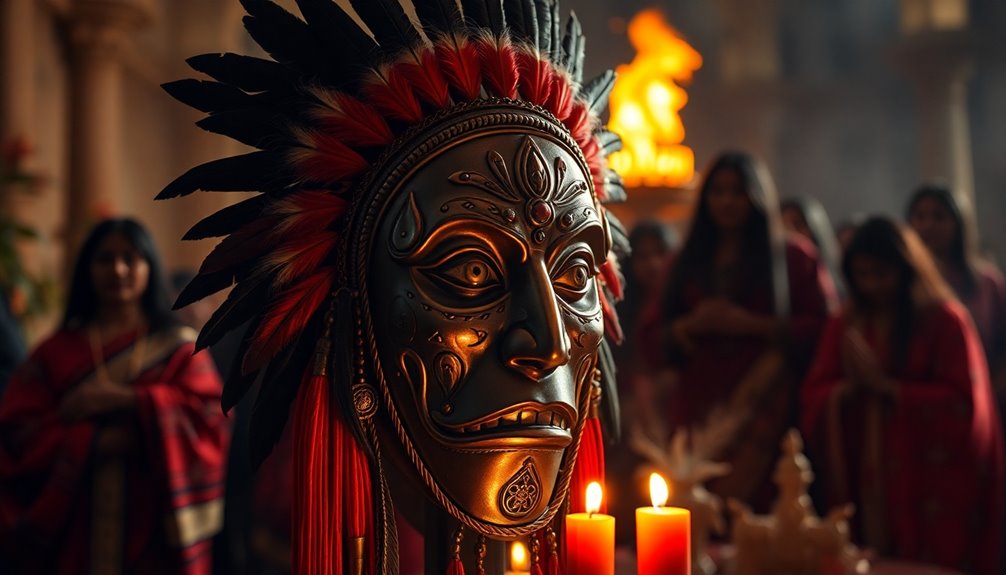
The evolution of death masks extends beyond their forensic applications, revealing deep cultural significance across various societies. Funerary masks, like those from ancient Rome and Egypt, played vital roles in rituals, connecting the living with the spiritual domain. By preserving the likeness of the deceased, these masks aided their passage to the afterlife and protected against malevolent spirits.
| Culture | Purpose of Masks |
|---|---|
| Ancient Rome | Celebrated political achievements |
| Ancient Egypt | Guided spirits to the afterlife |
| Various Cultures | Honored ancestors through generations |
Life masks also emerged as a way to memorialize individuals, ensuring their legacies lived on in the hearts and minds of their families.
The Role of Memory in Commemoration

Memory plays an essential role in how you commemorate those who’ve passed, especially through ancestral death masks.
These masks not only honor achievements but also weave a narrative of legacy that connects you to your roots.
Cultural Significance of Memory
While many cultures have developed unique ways to honor their deceased, the role of memory in commemoration remains a universal theme. Ancestral death masks serve as symbols that connect the living with their ancestors, reinforcing the importance of memory through various practices.
Here are some key points about their cultural significance:
- Tangible Connection: Death masks create a physical link to the past, allowing families to remember their ancestors.
- Political Legacy: In Roman households, displaying these masks highlighted the achievements of the deceased.
- Collective Memory: Annual festivals guaranteed that contributions of the deceased were celebrated and remembered.
- Identity and Continuity: Death masks foster a sense of belonging, linking generations through shared memory.
- Artistic Expression: The creation of death masks reflects a broader tradition of cultural storytelling that captures the essence of the individual’s life and legacy.
Rituals and Remembrance Practices
Rituals and remembrance practices play an essential role in connecting individuals with their ancestors, ensuring that the legacies of the deceased remain alive in the hearts of the living.
Ancestral death masks served as tangible reminders, creating a physical link that fostered continuity in memory. In ancient Rome, displaying these masks during funerals highlighted the importance of commemorating achievements and family heritage.
Annual festivals mandated acknowledging the deceased, integrating remembrance practices into cultural life. By remembering through masks and orations, you prevent the dead from fading into obscurity, affirming the belief in an afterlife.
Preserving multiple imagines within a family encourages you to aspire to the virtues and ambitions of your ancestors, enriching your own sense of identity and purpose.
Legacy Through Death Masks
Ancestral death masks not only embody the memories of those who’ve passed but also serve as powerful symbols of legacy. These tangible links foster continuity within families and communities.
Here are some key roles that death masks play in preserving legacy:
- Cultural Identity: They maintain connections to ancestors’ lives and achievements.
- Commemoration: Annual festivals honor the deceased, ensuring they aren’t forgotten.
- Inspiration: Displaying death masks emphasizes the accomplishments of the deceased, inspiring future generations.
- Collective Memory: The practice of creating death masks fosters shared remembrance, bridging past and present.
Through these functions, death masks greatly contribute to the legacy, reinforcing the importance of memory in commemorating those who came before us.
Death Masks Across Different Cultures

Death masks have long served as powerful symbols of remembrance and respect across various cultures.
In ancient Rome, these death masks commemorated the deceased’s political accomplishments, displayed during elite funerals to inspire virtues in the living.
Meanwhile, in ancient Egypt, death masks were essential to mummification, believed to protect the soul and lead it to the afterlife, with Tutankhamun’s gold mask standing out as a prime example.
Mycenaean Greece also produced notable gold death masks, reflecting the features of deceased individuals rather than just heroes.
The Etruscans crafted sheet-bronze masks for burial, attaching them to cinerary urns, showcasing their unique beliefs about life after death.
Together, these practices illustrate humanity’s timeless quest for memorialization across cultures.
Modern Interpretations and Artistic Reimaginings
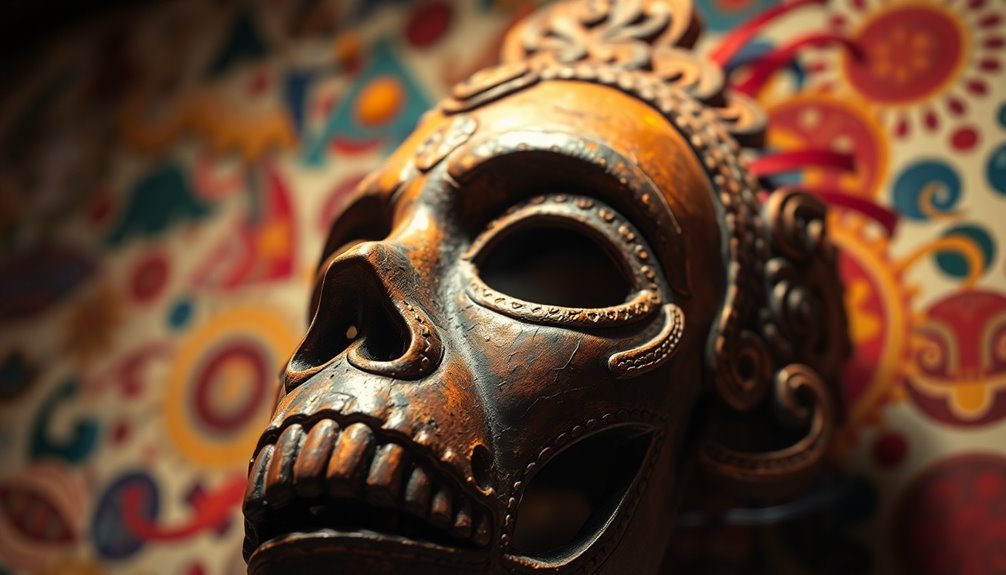
How do modern artists reinterpret the concept of death masks to reflect contemporary themes?
Today’s art challenges traditional views on mortality. Artists like Tracey Emin and Robert Gober use death masks to explore identity and personal narrative, creating works that provoke thought and discussion.
Consider these modern interpretations:
- Emin’s self-made death masks, exploring themes of identity and self-reflection.
- Gober’s fusion of his face with his deceased dog’s, merging personal loss with historical practices.
- The lifelike Resusci Annie mannequin, rooted in the death mask of L’Inconnue de la Seine, enhancing life-saving training.
- The revival of death masks, highlighting society’s ongoing fascination with mortality.
Through these works, artists invite us to reflect on memory and the human experience.
The Legacy of Death Masks in Contemporary Society
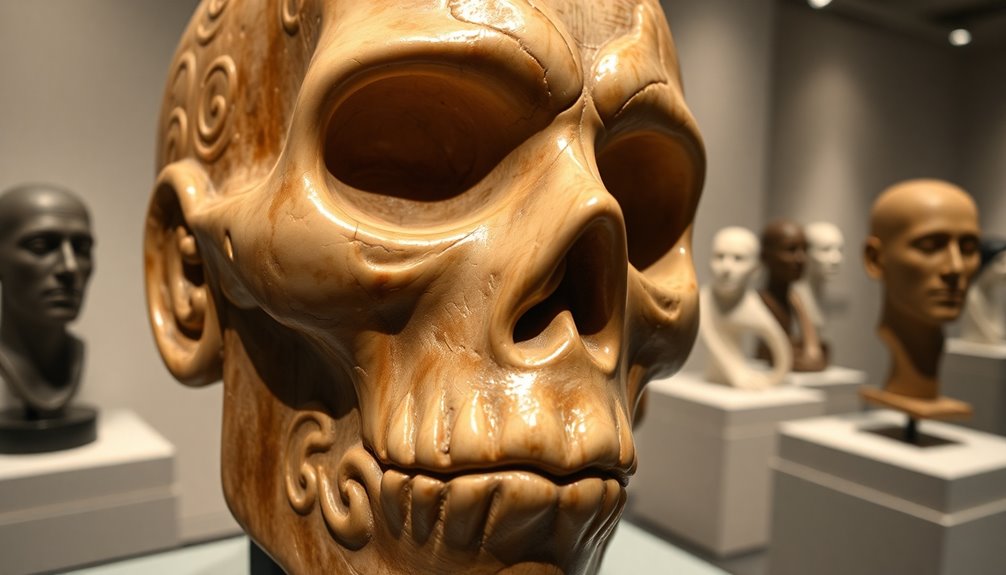
The enduring influence of death masks shapes how we remember and honor those who’ve passed. Their historical significance informs contemporary practices, intertwining art, medicine, and culture. From political commemorations in ancient Rome to modern artistic interpretations, the use of masks continues to resonate. Additionally, the emotional well-being of individuals experiencing loss can be enhanced through pet therapy as a means of coping and remembrance.
| Aspect | Historical Influence | Contemporary Relevance |
|---|---|---|
| Commemoration | Imagines in ancient Rome | Artworks by Emin and Gober |
| Memory & Representation | Cultural practices surrounding masks | Modern funeral customs |
| Medical Applications | Historical death masks | Resusci Anne training mannequin |
| Artistic Expression | Challenges to mortality | Renewed discussions on identity |
| Connection to Ancestors | Preserving legacies | Engaging the living |
These reflections remind you of the faces of the dead, bridging past and present in meaningful ways.
Frequently Asked Questions
What Is the Significance of the Death Mask?
The significance of the death mask lies in its role as a cultural artifact that preserves memory and honors the deceased.
You’ll find these masks serve not just as representations of individuals but also as symbols of lineage and status. They foster a connection between the living and the dead, emphasizing continuity.
Additionally, their use in scientific contexts has advanced our understanding of human features, making them invaluable in both art and forensic science.
What Is the Historical Significance of Masks?
Did you know that nearly 80% of ancient cultures used masks in rituals? Masks hold immense historical significance, serving as powerful symbols for identity, social status, and cultural beliefs.
You see, they’ve often been utilized in ceremonies to connect the living with the spiritual world. By wearing a mask, you transform, embodying different personas and reflecting societal values, rituals, and artistic expression.
This deep-rooted practice has shaped human culture across generations, creating lasting connections.
What Was the Purpose of Death Masks in Roman Art?
In Roman art, death masks served to honor and commemorate the deceased. You’d see these wax models, crafted to closely resemble the individual, displayed prominently during funerals.
They weren’t just for remembrance; they inspired you to aspire for greatness, showcasing the political achievements of ancestors. As you reflected on these masks, you’d feel a connection to your heritage, encouraging a sense of pride and ambition within your own societal contributions.
What Was the Purpose of Egyptian Death Masks?
When it comes to Egyptian death masks, they’re more than just a pretty face.
You’ll find that these masks served an essential purpose in ancient culture. Crafted to resemble the deceased, they guided the spirit back to its body after death. They also protected the soul from malevolent spirits during the afterlife journey.
Fundamentally, these masks embodied the belief that the physical form was critical for the soul’s survival beyond this life.
Conclusion
In the tapestry of history, death masks symbolize the enduring bond between life and memory. They remind us that every face tells a story, echoing the voices of those long gone. As you explore their legacy, consider how these artifacts bridge the past and present, shaping our understanding of identity and loss. Just like a whisper carried by the wind, death masks invite you to remember, reflect, and honor the lives that once were, forever etched in time.








